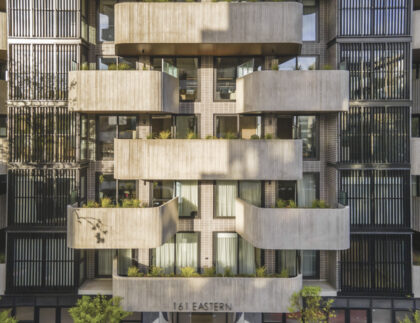A lush, living green façade enhancing biodiversity, learning, and urban greening
Location - St Kilda Primary School,
2B Brighton Road, St Kilda Victoria
Client - Lloyd Group
Architect -Law Architects
Webmesh - Tensile Design & Construct
Design & Install - Fytogreen Australia
Photos - Derek Swalwell
Completion - November 2021
The redevelopment of St Kilda Primary School included a new two-storey learning centre (Nozomi) and a vibrant outdoor learning and play space. A key feature of this space is the green façade, which enhances the building’s sustainability and provides a living, educational landscape for students.
Fytogreen’s Scope of Work
Fytogreen was responsible for the supply, installation, and horticultural design of the green façade and associated planter boxes. The total measured garden area was 311 m². The installation was completed in November 2021. Fytogreen was contracted by Lloyd Group.
Growing Media – HY40 with Hydrocell
The planter boxes at St Kilda Primary School were filled with 540 mm of Fytogreen’s HY40 extensive growing media, a lightweight, engineered substrate designed for optimal plant health and sustainability. A key component of this mix is Hydrocell, a sterile and inert additive that significantly enhances water retention and aeration. Hydrocell absorbs water instantly upon contact and retains it within the root zone, making it ideal for hydrophobic conditions. Its inclusion helps prevent soil compaction, supports consistent moisture availability, and contributes to the long-term success of the green façade and planter systems.
Planting Strategy
Fytogreen designed and supplied a diverse planting scheme tailored to the microclimates and educational goals of St Kilda Primary School. Across the green façade, planter boxes, and soft landscape areas, a total of 1,943 plants were installed, representing 35 different species. This selection includes a mix of native, exotic, and sensory plants, chosen for their resilience, ecological value, and educational potential.
The planting palette was curated to support biodiversity, seasonal interest, and student engagement. For example, Trachelospermum jasminoides (Star Jasmine) was used for its vigorous climbing habit and fragrant flowers, while Rosmarinus officinalis prostrata (Prostrate Rosemary) adds both sensory appeal and drought tolerance.
This thoughtful mix ensures year-round greenery, supports pollinators, and aligns with the school’s sustainability curriculum. The planting design also considers long-term maintenance and adaptability to Melbourne’s climate.

GREEN FACADE AND PLANTER BOXES . TOTAL 311m2 . 35 SPECIES . 1,943 PLANTS















